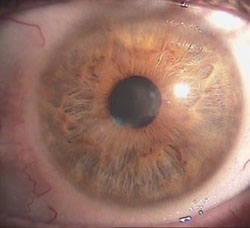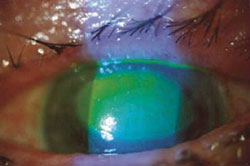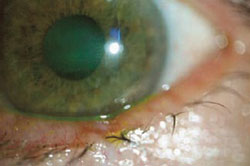Amniotic membrane extract shows promise in treatment of corneal epithelial defects
Early clinical study results suggest stimulation of corneal wound healing.
Click Here to Manage Email Alerts
 Kenneth R. Kenyon |
An innovative product based on lyophilized human amniotic membrane allows topical application to the ocular surface of unlimited quantities of amniotic membrane biological factors.
According to the preliminary results of an ongoing European study, the product is safe and stimulates healing of persistent defects of the corneal epithelium.
“In other words, it accomplishes what amniotic membrane grafting does, but in an easier, painless, cheaper and patient-friendly way, without the need for surgery,” Kenneth R. Kenyon, MD, said in an interview with Ocular Surgery News.
Development and study
Five years ago, Emiliano Ghinelli, MD, began the development of amniotic membrane extract (AMX). AMX is currently produced under license from Keera in collaboration with the Veneto Tissue Bank in Italy. It is not yet commercially available but is undergoing evaluation in a multicenter clinical trial.
“The immediate clinical application of AMX has been to promote wound healing of persistent corneal epithelial defects occurring as serious complications of several corneal conditions, most commonly herpes simplex or zoster, trigeminal nerve defect, or diabetes,” Dr. Kenyon, OSN U.S. Edition Cornea/External Disease Section Editor Emeritus, said.
|
|
|
|
Herpes simplex keratitis with corneal
ulceration, inflammation and neovascularization resolved after AMX
treatment. |
|
|
|
|
|
Persistent corneal epithelial defect due to
acoustic neuroma healed by AMX therapy.
Images: Kenyon KR |
|
Approximately 50 patients have been enrolled in the trial, and the final outcome analysis should be available within the next 2 months. Preliminary indications suggest that there are no safety concerns and that corneal wound healing has improved in the majority of cases. The therapeutic efficacy of AMX appears to be comparable to, or perhaps better than, that of amniotic membrane graft, but further data are needed.
Preliminary study results were presented at the International Symposium on Ocular Pharmacology and Therapeutics meeting in Rome in December.
Numerous advantages
The AMX preparation is in the form of a lyophilized powder, which requires the addition of saline for reconstitution as an eye drop. As it is non-preserved, it must be retained in normal refrigeration for no longer than 72 hours.
An advantage of AMX is that it can be applied topically as an eye drop at a frequency determined by the severity of the condition, “typically beginning hourly and then rapidly decreasing,” Dr. Kenyon explained.
Besides not requiring the time, effort and expense of a surgical procedure, the lyophilized product overcomes the limitations of amniotic membrane grafts, which can only be effective for as long as their content of growth factors and other bioactive factors remains viable.
“With AMX, we can continue to provide the wound healing factors directly and continuously, at the site where they are needed and for as long as they are needed,” Dr. Kenyon said.
From the point of view of the patient, being treated by off-the-shelf topical medications rather than surgery holds obvious advantages.
“Compliance is better, quality of life is better, and patients are more relaxed,” he noted.
Dr. Kenyon said that, besides the indications that are currently investigated in the study, AMX has many other potential ocular and possibly dermatological applications.
“This product may perhaps be useful following refractive surgery, in severe dry eye, and in various other ocular surface disorders,” he said. – by Michela Cimberle

- Kenneth R. Kenyon, MD, can be reached at Eye Health Vision Centers, 51 State Road, Dartmouth, MA 02747, U.S.A., or Cornea Consultants International, Tal 13, 80331, Munich, Germany; +1-508-994-1400; fax: +1-508-992-7701; e-mail: kenrkenyon@cs.com. Dr. Kenyon and Dr. Ghinelli have a financial interest in the development of amniotic membrane extract through Keera.




